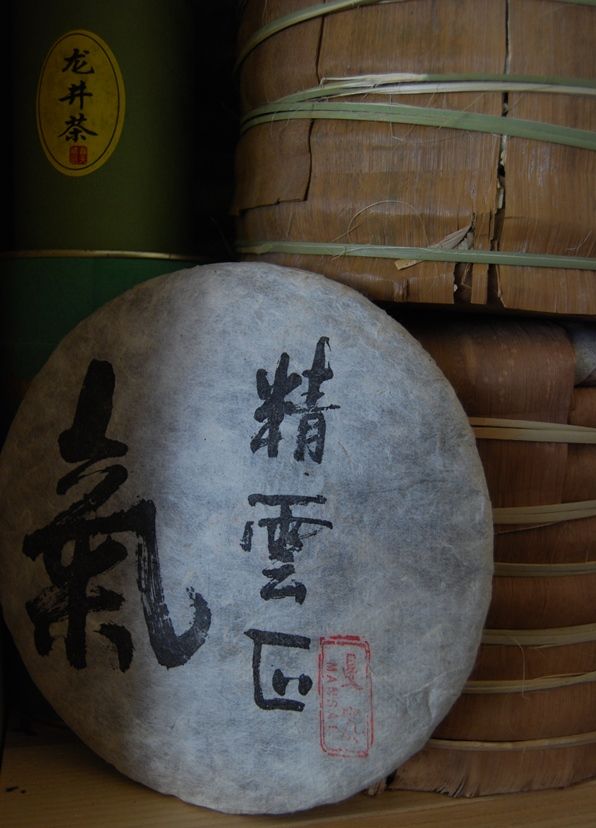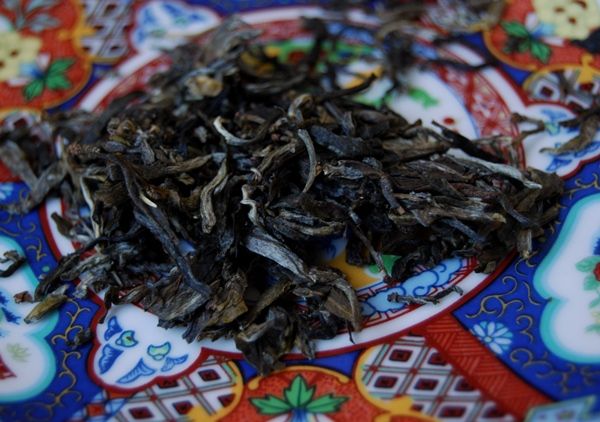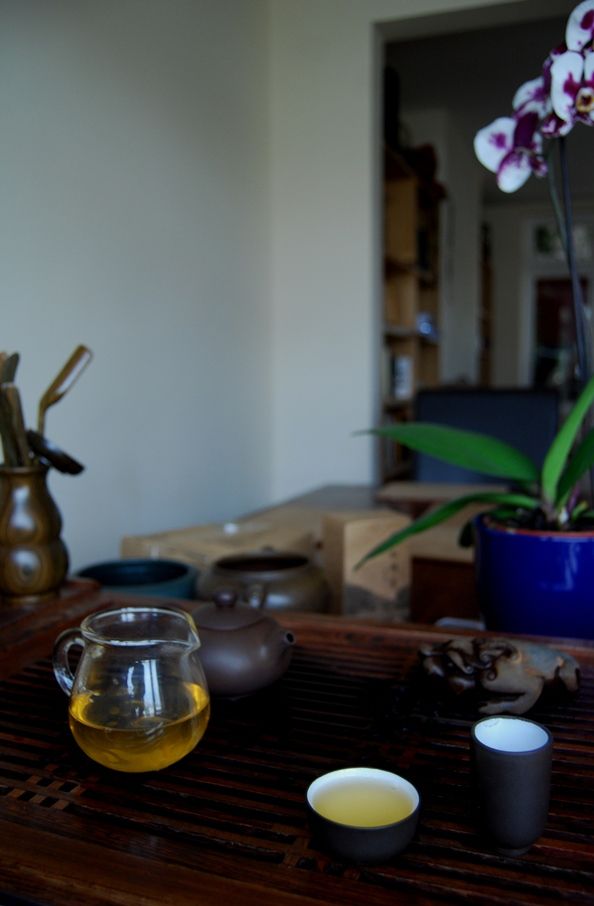The 2010 Mansai from Essence of Tea reminded me of my love for fat, beefy pu'ercha. Since then, a tong of it has been squatting on my shelves, its flabby waistline pushing aside its more slender contemporaries. It is a fine tea.
This year, Mr. and Mrs. Essence returned to Mansai, which is in the area near Bulangshan that is currently disputed between the Zhonglish and Myanmar governments.
Pictured above, the leaves are typically attractive, despite Nada's description of there being increased breakage due to the long journey between remote Mansai and the factory in which the bing were pressed.
Unsurprisingly, it brews a straight, yellow soup. Like last year's cake, there is quite a lot to hold the attention: it has sweet butter, summer fruits, and all manner of darkened tobacco in the aftertaste. Smooth, clean, and very proper, its long journey has not noticeably affected its quality.
Moreso than the other cakes of this year, the Mansai has a broad base of "tea" flavour.
Its kuwei is strong, but not punishing, which, along with its sheer density of character, gives me hope for its long-term prospects.
In my diary, I wrote "Excellent, but not as fun as the Mannuo."
Inevitably, I weigh the tea against its price. Last year, my records state that this was £25 (currently £30 for the 2010), while the 2011 is selling at £38. An eye-watering, wallet-achingly large increase of 52% over the previous year prevents me from buying more than a test cake, but it is delicious and heartily recommended. I think, overall, last year's price could be described as a substantial bargain, and this year's price more accurately reflects its place in the overall scheme of Western pricing.




10 comments:
So there are no notably different characteristics about the 2011 compared to the 2010? The 2010 is still around, you know, and for 8 less pounds and one more year of age...
--shah8
Dear Shah,
I haven't returned to the 2010 since first acquiring it, and so couldn't really comment. If I were buying cakes, though, I would be very tempted to look at the 2010 line-up, even after their recent increase in price.
Toodlepip,
Hobbes
Absolutely, Hobbes. I revisted the three samples I had and made a purchase of the Bangwai accordingly. They seem like bargains compared to 2011.
This tea's origin right by the Burma border reminds me of something I think about from time to time: when will we see frankly Burmese tea lifting its head and announcing itself in the market? I don't doubt that there's Burma maocha in some cakes we've tasted, but...
I'd buy some unashamedly Burmese tea. We could call it the "Mountbatten".
Maybe it's already available within Burma / Myanmar, selling for low prices as was puer'cha once...
Lew and Hobbes, I second your comments on Myanmar (Burma) tea! It has been common practice for Bulangshan locals to acquire tea over the border and blend it into their more expensive maocha. In this case, we've likely unwittingly sampled tea from across the border.
I've met folks from China, Taiwan, and Bulangshan (locals) who are producing Myanmar oolongs and greens, though presumably from new taidi plantings (and official junta blessings?). Very much looking forward to verifiable Myanmar old-growth and wild pu'ers!
While I haven't crossed the border yet, I have been a stream-crossing away. And, recently, I've been researching the state of tea in Myanmar, relying on historical colonial accounts, contemporary news reports, and interviews within Yunnan.
Conditions that make acquisition of such tea difficult include, first and foremost, the political oppression in Shan state which has subverted the local tea industry and made access to the region (described in one 19th century account as "a vast vale of tea") extremely difficult. Secondly, local production has traditionally been oriented towards "miang" - fermented, edible tea - sold south, with a small amount of maocha making its way to China. Production standards for maocha likely remain very low.
While it is compelling to think of this region as a nascent pu'er frontier, we have to consider the conditions under which this is possible. I wonder if, as China continues to extend its economic influence across the border, we will see the same situation that has transpired in Xishuangbanna since the 1950's? So far, there is a similar trajectory, as rubber and other commercial crops wrest land away from locals and otherwise challenge cross-border landscapes and livelihoods. We can thank teas presence at higher elevations, where rubber cannot reach, for the hope that what old-growth and wild tea still exists will be preserved. And we can pray that one day the uplands of Myanmar will find peace and reconstitute their rich tea culture.
Before that, I would expect more authentic, high-quality Laos sourced pu'er to appear in the market, the current climate there being far more conducive to (relatively healthy) exploitation. I'm surprised we haven't seen more of this already, though perhaps it is being branded as Yiwu tea (i.e. Guafengzhai, etc.)?
I do have some verifiably wild tree Laos cakes sourced and produced during an intrepid, joint expedition by a Taiwanese and Kunming producer in 2005. I haven't visited this tea in awhile, but would be happy to provide samples and revisit it with folks if anyone is interested.
Peace,
BSK
Dear BSK,
The Tea Institute at Penn State would be interested in a sample of your wild tree Laos Pu'er(!).
We would also like as much info on it as you could give us...
You can follow up with me by email: jmc5840@psu.edu
Thank you for this opportunity!
All the Best,
Jason
PS
Thank you Hobbes for the community you and other tea bloggers have created.
I am always game for new tastes, you can probably find a way to contact me on forums.
--shah8
Dear BSK,
A fascinating story, thanks for the long comment. I'd be delighted to try some actual Laos old-tree tea - I have not tried such a type before (apart from the unadmitted mystery blends). Perhaps, as you say, real Laos tea is in our future.
My e-mail address is hobbesoxon 'at' gmail 'dot' com. What an expected treat! Thanks again.
Toodlepip,
Hobbes
Shah 82
I have noticed some differences in the two mansai the 11 has noticably stronger cha qi but the 2010 had more ku.
aneglakya
I would love to sample lao lao shu.
you can reach me at jewellsoftheearth at gmail.com
gasninja
Post a Comment